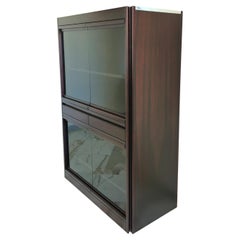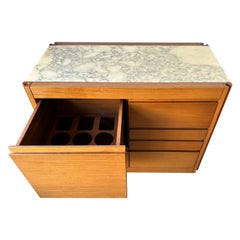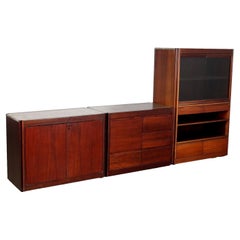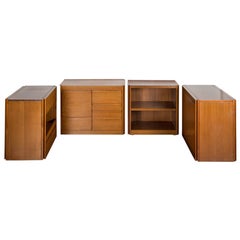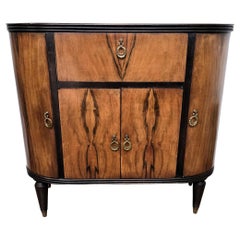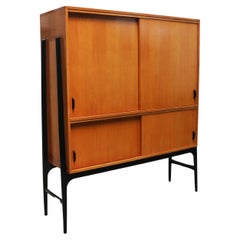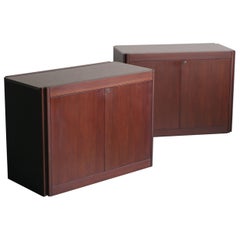Molteni & C Cabinets
to
1
Height
to
Width
to
Depth
to
4
4
3
4
3
1
2
1
4
3
3
1
1
3
3
4
4
4
110
80
79
72
67
Creator: Molteni & C
Highboard by Mangiarotti for Molteni 4d Mid-Century Modern Design Italy 1964
By Angelo Mangiarotti, Molteni & C
Located in Palermo, IT
Cabinet by Angelo Mangiarotti for Molteni, Italy 1960s
Freestanding cabinet in mahogany by the Italian architect Angelo Mangiarotti, produced by Molteni in the 1960s. Equipped with 4...
Category
Mid-20th Century Italian Mid-Century Modern Molteni & C Cabinets
Materials
Carrara Marble
Wood and Marble Dry Bar Cart by Angelo Mangiarotti for Molteni, Italy, 1960s
By Angelo Mangiarotti, Molteni & C
Located in SAINT-OUEN, FR
Dry bar cart cabinet in wood and marble top by the italian designer Angelo Mangiarotti for Molteni, the bar is mounted on wheels. Famous design like Mario Sabot, Willy Rizzo, Maison ...
Category
1960s Italian Mid-Century Modern Vintage Molteni & C Cabinets
Materials
Marble
4D modular furniture by Angelo Mangiarotti for Molteni, 1970s
By Angelo Mangiarotti, Molteni & C
Located in Milano, IT
Modular furniture from the 4D series for Molteni, with storage elements with hinged doors and drawers, exotic wood veneer and marble tops, all 3 pieces of furniture have small wheels...
Category
1970s Italian Mid-Century Modern Vintage Molteni & C Cabinets
Materials
Marble
$1,711 Sale Price / set
20% Off
Set of Four "4D" Walnut storage system by Angelo Mangiarotti for Molteni, 1960s
By Angelo Mangiarotti, Molteni & C
Located in Milan, IT
Set of four "4D" storage system units by Angelo Mangiarotti for Molteni.
Totally built in walnut these pieces are finished on all 4 sides; this allows to use them as side tables or ...
Category
1960s Vintage Molteni & C Cabinets
Materials
Walnut
Related Items
1960s Art Deco Mid-Century Italian Walnut Burl and Mirror Mosaic Dry Bar Cabinet
By Ico & Luisa Parisi, Vittorio Dassi, Gio Ponti, Paolo Buffa, Guglielmo Ulrich
Located in Carimate, Como
Beautiful Italian Art Deco Mid-Century Modern dry bar cabinet decorated in various veneer briar burl wood, with two side doors, central slant door and antique brass handles. When ope...
Category
Mid-20th Century Italian Art Deco Molteni & C Cabinets
Materials
Brass
$2,377 Sale Price
20% Off
H 31.5 in W 33.47 in D 16.15 in
Rare Belgium Mid-century Design highboard by Alfred Hendrickx for Belform 1958
By Alfred Hendrickx, Belform
Located in Ijzendijke, NL
Alfred Hendrickx’s design vision is evident in every detail of this highboard designed & produced in 1958. Its sleek lines, minimalist form, and functional elegance make it a standou...
Category
1950s Belgian Mid-Century Modern Vintage Molteni & C Cabinets
Materials
Glass, Wood
$6,834
H 62.21 in W 55.12 in D 16.54 in
Midcentury Wood, Steel & Glass Dry Bar by Carlo De Carli for Fiarm, Italy 1960s
By Carlo di Carli, Fiarm
Located in Rome, IT
Midcentury rare amazing cabinet dry bar with storage for bottle and sliding doors in wood, steel, black laminate and glass by Carlo De Carli for Fiarm.
Made in Italy in the 1960s.
...
Category
1960s Italian Mid-Century Modern Vintage Molteni & C Cabinets
Materials
Metal
$6,240
H 46.07 in W 25.2 in D 22.45 in
Chest of Drawers Made In Teak With Four Drawers From 1960s
Located in Lejre, DK
This teak chest of drawers with four drawers is a beautiful example of Danish design from the 1960s. With its characteristic teak material, the chest of drawers radiates warmth and n...
Category
1960s Danish Mid-Century Modern Vintage Molteni & C Cabinets
Materials
Teak
$618 Sale Price
25% Off
H 30.32 in W 29.93 in D 16.54 in
Vintage Italian World Globe Dry Bar, 1960s
Located in Miami, FL
This vintage 1960s Italian dry bar is perfect for adding a touch of classic European flair to your home. The globe design is made of wood, giving it an authentic and timeless look. T...
Category
Mid-20th Century Spanish Mid-Century Modern Molteni & C Cabinets
Materials
Wood
Vintage Palaset Palanox Modular Storage Box Set of 9, White Brown Finland, 1972
By Palaset, Ristomatti Ratia
Located in Brooklyn, NY
Vintage Palaset Palanox modular storage box set of 9, White and Brown, Finland, 1972. Palaset Palanox, multicolored stackable boxes that allow you to build your own shelf, only prod...
Category
Mid-20th Century Finnish Scandinavian Modern Molteni & C Cabinets
Materials
Metal
$3,112 Sale Price / set
20% Off
H 39 in W 39 in D 13 in
1970s pair of Plastic Modular Cabinets by Anna Castelli Ferrieri for Kartell
By Kartell
Located in Milano, IT
1970s Original pair of cylindrical cabinets by Anna Castelli for Kartell, modular with vertical overlap was designed for every room. A true pieces of italian design. The items are in...
Category
1970s Italian Mid-Century Modern Vintage Molteni & C Cabinets
Materials
Plastic
$980 / set
H 22.83 in Dm 12.6 in
1950s Midcentury Regency Italian Wood, Brass and Mirror Dry Bar Cabinet Cart
By Guglielmo Ulrich, Ico & Luisa Parisi, Paolo Buffa, Gio Ponti, Vittorio Dassi
Located in Carimate, Como
Very elegant Italian Art Deco Mid-Century Modern dry bar cabinet cart characterized by its original Asian themed painted front wood pull-out tilt door with interior part in mirror glass, standing on its antique brass wheels...
Category
Mid-20th Century Italian Mid-Century Modern Molteni & C Cabinets
Materials
Brass
$1,569 Sale Price
20% Off
H 27.96 in W 28.75 in D 14.57 in
Dry Bar with Stool in Rattan, Bamboo and Wicker by Tito Agnoli, Italy 1950s
By Tito Agnoli
Located in Roma, IT
Marvelous Mid-Century organic dry bar in a gorgeous mix of bamboo, curved rattan, woven wicker and formica. This stylish bar was designed by Tito Agnoli and made in Italy during the ...
Category
1950s Italian Mid-Century Modern Vintage Molteni & C Cabinets
Materials
Bamboo, Wicker, Cane, Rattan, Formica, Wood
$3,328 Sale Price
20% Off
H 42.52 in W 54.34 in D 22.45 in
Mid century highboard, 1960s
Located in Leuven, Vlaams Gewest
Great looking mid century bar cabinet with beautiful veneer wood and a chrome and wooden base.
The bar cabinet consists of 2 doors and 2 drawers providing loads of storage space.
V...
Category
1960s Belgian Mid-Century Modern Vintage Molteni & C Cabinets
Materials
Wood
Ledge Dry Bar by Simon Johns
By Simon Johns
Located in East-Bolton, Quebec
Ledge dry bar is a floating wall-mounted sculptural dry bar. Made of carved solid ash, it’s surface recalls the textures of crumbling cliffs around the studio. It’s interior has two solid wood surfaces for a collection of bottles...
Category
2010s Canadian Post-Modern Molteni & C Cabinets
Materials
Leather, Glass, Ash
Vintage Palaset Palanox Modular Storage Box Set of 4, Green White, Finland, 1972
By Ristomatti Ratia, Palaset
Located in Brooklyn, NY
Vintage Palaset modular storage box set of 4 Scandinavian Modern, Finland, 1972-1973, green and white.
Palaset Palanox, multicolored stackable boxes th...
Category
Mid-20th Century Finnish Scandinavian Modern Molteni & C Cabinets
Materials
Metal
$7,130 / set
H 52 in W 13 in D 13 in
Previously Available Items
Pair of Cabinets by Angelo Mangiarotti
By Molteni & C, Angelo Mangiarotti
Located in Dronten, NL
These elegant mahogany cabinets with stone tops where designed by Angelo Mangiarotti for Molteni.
With their invisible built-in wheels they allow for very versatile use as room div...
Category
1960s Italian Mid-Century Modern Vintage Molteni & C Cabinets
Materials
Granite
Molteni & C cabinets for sale on 1stDibs.
Molteni & C cabinets are available for sale on 1stDibs. These distinctive items are frequently made of wood and are designed with extraordinary care. There are many options to choose from in our collection of Molteni & C cabinets, although brown editions of this piece are particularly popular. If you’re looking for additional options, many customers also consider cabinets by Leonardo Fiori, ISA Bergamo, and Guillerme et Chambron. Prices for Molteni & C cabinets can differ depending upon size, time period and other attributes — on 1stDibs, these items begin at $7,500 and can go as high as $7,500, while a piece like these, on average, fetch $7,500.
Creators Similar to Molteni & C
Questions About Molteni & C Cabinets
- What are C hoop earrings?1 Answer1stDibs ExpertNovember 14, 2023C hoop earrings are hoops with a specific design. Unlike circular hoops, they have a distinctive C shape. At the top of the C is usually a post that slips into your ear piercing and is secured by a backing. The bottom end of the C usually hits behind or below the ear, depending on the size of the earrings. Shop a large collection of hoop earrings on 1stDibs.
- What is the double C logo?1 Answer1stDibs ExpertAugust 8, 2024The double C logo is the logo of the French luxury fashion house Chanel. Its founder, Gabrielle "Coco" Chanel, designed the logo in 1925. Her initials served as its inspiration. Today, the iconic logo appears on many of Chanel's handbags, jewelry pieces and other items. Explore a wide range of Chanel apparel, bags and accessories on 1stDibs.
- What did T. C. Cannon paint?1 Answer1stDibs ExpertApril 5, 2022Tommy Wayne Cannon, most often known as T. C. Cannon, was a Native American painter known for his depictions of Indigenous American subjects. On 1stDibs, shop a collection of expertly-vetted T. C. Cannon paintings from some of the world’s top art dealers.
- 1stDibs ExpertApril 5, 2022Jewelry makers mostly used C clasps on brooches during the 1890s and early 1900s. However, some designers continued to use them up until the 1930s. The clasp resembles a simple hook. Find a selection of antique and vintage brooches on 1stDibs.
- 1stDibs ExpertMarch 22, 2022Curtis Jeré, sometimes called C. Jeré, is not a single artist. Rather, the name refers to the team of Curtis Freiler and Jerry Fels. The New York-based designers were active throughout the 1960s and 70s. Together, they created numerous sculptures, lamps and mirrors. On 1stDibs, find a collection of Curtis Jeré.
- 1stDibs ExpertAugust 20, 2024To tell if an M. C. Escher print is real, examine its details with a magnifying glass. If you see any pixelation, the piece is likely a reproduction. Escher used lithographic techniques to produce his prints, and this method usually involves heavy paper with a noticeable grain and a thicker application of ink. As a result, smooth or glossy paper or fine, light linework typically indicates that a print is a copy. A certified appraiser or knowledgeable art dealer can further assist you with the authentication process. On 1stDibs, shop a collection of M. C. Escher art.
